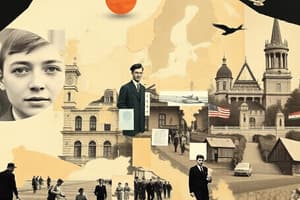Podcast
Questions and Answers
Koji pojam opisuje prijelaz s visoke smrtnosti i rodnosti na nisku smrtnost i rodnost?
Koji pojam opisuje prijelaz s visoke smrtnosti i rodnosti na nisku smrtnost i rodnost?
- Gustina stanovnika
- Demografska tranzicija (correct)
- Vojno političke organizacije
- Populacijska politika
Koje su službene jezike Belgije?
Koje su službene jezike Belgije?
- Mađarski, slovački, latvijski
- Talijanski, španjolski, njemački
- Zvončarski, francuski, engleski
- Nizozemski, francuski, njemački (correct)
Koji val iseljavanja se dogodio kao rezultat geografske otkrića iz pirenejskih država?
Koji val iseljavanja se dogodio kao rezultat geografske otkrića iz pirenejskih država?
- Drugi val
- Četvrti val
- Treći val
- Prvi val (correct)
Koja organizacija službeno predstavlja Europsku uniju?
Koja organizacija službeno predstavlja Europsku uniju?
Koja je najgušće naseljena regija u Europi?
Koja je najgušće naseljena regija u Europi?
Koji oblik vlasti ima monarhija?
Koji oblik vlasti ima monarhija?
Koja je organizacija odgovorna za gospodarsku suradnju i razvoj između zemalja članica?
Koja je organizacija odgovorna za gospodarsku suradnju i razvoj između zemalja članica?
Koja je uloga šengenskog sporazuma?
Koja je uloga šengenskog sporazuma?
Flashcards
Demografska tranzicija
Demografska tranzicija
Prijelaz od visoke smrtnosti i rodnosti do niske smrtnosti i rodnosti u populaciji.
Monarhija
Monarhija
Oblik države kojom vlada kralj ili kraljica.
Najgušće naseljena regija u Europi
Najgušće naseljena regija u Europi
Zapadna Europa.
Europska unija (EU)
Europska unija (EU)
Signup and view all the flashcards
Populacijska politika
Populacijska politika
Signup and view all the flashcards
Službeni jezici Belgije
Službeni jezici Belgije
Signup and view all the flashcards
Nastanak EU-a
Nastanak EU-a
Signup and view all the flashcards
Iseljavanje (migracije)
Iseljavanje (migracije)
Signup and view all the flashcards
Study Notes
Population and Demographics
- 741 million inhabitants
- Population density: 74 people/km²
- Population structure: More men than women, more older people than younger
- Demographic transition: Shift from high birth and death rates to low birth and death rates
European Languages and Groups
- Major Indo-European language families: Slavic, Germanic, Uralic, Romance, Altaic, others
- Official languages in certain regions: Netherlands, French, and German in Belgium; Romansh, French, German, and Italian in Switzerland
- Religious groups: Orthodox Christians (East and Southeast Europe), Catholics (Central and Western Europe), Protestants (Northern Europe), Muslims (Southeast Europe)
European Migration
- Four major waves of emigration
- 1st: Age of Exploration
- 2nd: 19th and early 20th centuries
- 3rd: Post-World War II
- 4th: Contemporary periods.
- Reasons include geographic discoveries, industrial revolutions, and political conflicts.
European Political and Economic Organizations
- European Union (EU) established in 1951
- Institutions: European Parliament (Strasbourg), European Commission (Brussels), Council of the European Union (Brussels), European Council (Brussels), and European Court of Justice (Luxembourg)
- Economic integrations: NATO, EU, Council of Europe; and various economic and free trade agreements like the Schengen Agreement, EFTA, OECD, and CEFTA.
Studying That Suits You
Use AI to generate personalized quizzes and flashcards to suit your learning preferences.




